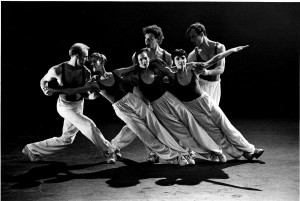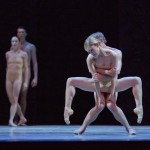[I]n this new series, we meet dancers who’ve blazed intriguing new paths after a fulfilling performing career. Our first profile is of Kevin Irving, founder of the non-profit I-DANCE:

Kevin Irving, far left, in Nacho Duato's ‘Jardi Tancat’ (Les Grands Ballets Canadiens). Photo: Michael Slobodian.
Tell us about your dance background.
Kevin: I was extremely fortunate as a dancer: I found my way into dance really late, yet at virtually every step was encouraged by passionate and dedicated teachers.
My very first teacher, Marianne Anderson (now Santilli) welcomed me with open arms when I stumbled into the studio that was in the basement of her parents’ house in the town where I grew up. She not only built up my confidence, she recognized when I had outgrown her ability to feed my need for new information and pushed me to “think bigger.”
I had the enormous good fortune to be given a scholarship to study at the Alvin Ailey American Dance Center and particularly remember Alvin himself encouraging me. Other teachers along the way, especially Larry Rhodes, Benjamin Harkavy and Maggie Black, helped me to navigate an unexpected turn towards classical ballet after I joined Les Grands Ballets Canadiens – at age 24! But I really came into my own working with the stagers and choreographers who introduced me to the world of contemporary ballet – Sally Leland who cast me in the Agon pas de deux on my first day of work in Montreal, Anna Markard who taught me her father Kurt Joos’ seminal Green Table, Nacho Duato, Lar Lubovitch and James Kudelka.
So many wonderful artists who shared their insights with me because I was in the right place at the right time. It seemed like a natural transition for me to begin coaching and rehearsing dancers alongside Nacho Duato, in Madrid, because I felt I had learned so much about the art throughout my performing career.
What led you to start I-DANCE?
Kevin: There was one personal experience that really guided me to create I-DANCE, and I have been a bit reluctant to speak about it until now. I was, for five years, the artistic director of the Göteborg Ballet in Gothenburg Sweden. It was, overall, a wonderful experience and a tremendous opportunity for me – but when I decided to leave Sweden, I did so with something of a bitter taste in my mouth. You see, I was often disappointed in the attitude of many of the dancers there because their outlook on their working conditions and opportunities seemed so negatively skewed… In spite of nearly 100% job security (it is next to impossible to be removed from a contract after three seasons – under any conditions), comfortable salaries, paid vacation and many scholarship chances for additional training, free training clothes, shoes, detergent, and make-up, all provided by the gorgeous theater they worked in, and a repertory that represented a diverse cross section of high caliber artists who came to work with them, including many visiting guest teachers – many (but fortunately not all!) in the group seemed to feel that their working conditions were terrible.
Upon leaving such a privileged state, I felt that I needed to connect with dancers who were less well-off in both the material and the artistic sense.
My own first step was to volunteer to teach in Managua in 2007 and it was while on that trip that my eyes were really opened. What struck me quite clearly was that there was very little difference in why those dancers wanted to dance – but there was a huge chasm between them and the greater dance community. They have been relatively isolated – mainly by geography and politics – and although the impulse to dance is there, and although advances in technology may have given them greater access to inspiration, there is little on-the-ground training and little of the hands-on mentoring that is so essential to passing on the art. And I thought it was worthwhile to try and change that dynamic. Having benefitted from inspiring teachers my whole dance life, I know how much those experiences can impact young dancers.
Having an idea is one thing; being able to execute is another. Especially in today’s dance world where even the largest, best-resourced companies are barely able to finance their own seasons, let alone provide mentoring for artists in far-flung places. How did you get this off the ground?
Kevin: In 2007, partly through coincidence and partly from instinct, I volunteered to teach an intensive workshop in Nacho Duato repertory in Managua, Nicaragua. At that point in time, I knew nothing whatsoever about the conditions there or how they approached dance. My host in Nicaragua was Gloria Bacon Hodgson – a woman who has single-handedly and with precious few resources curated and presented the International Festival of Contemporary Dance in Nicaragua for over 15 years. Ms. Bacon Hodgson opened up her studio to dancers from the diverse professional and pre-professional community and we offered them, free of charge, the chance to learn a style of dance that they had heard of but never experienced. It was while on this trip that I realized a couple of very important things:
First of all, the instincts that drive dancers to want to dance are the same everywhere you go. The young dancers I encountered in Nicaragua were as hungry and as energetic as dancers I have encountered in professional companies all over the world.
Second, without access to teachers and training that reflect current trends and understanding in dance, dancers do not have the resources to emerge out of their small communities or to engage with the wider dance world.
Unfortunately for many dancers in Latin American countries, this is the situation they find themselves in – with a huge surplus of drive and ambition but little opportunity to learn from highly experienced teachers. Conversely, we here in the U.S.A. have abundant resources to share and little direct contact with our neighbors to the south.
Latin America is surely not the only geographical area where this situation exists – but I have chosen to focus on Latin America for a couple of simple reasons. The first reason is the region’s proximity to the United States: our neighbors to the south are really not so far away and yet they remain, for reasons political and economic (for the most part), very isolated from us. (An additional reason that Latin America’s proximity to the USA is relevant is that the cost of traveling there is relatively inexpensive – part of the idea behind I-DANCE is that we have a very low overhead and can make a little bit of funding go a long way.) The second reason that I have decided to focus on Latin America is because it appears to me that there is a need for more bridge building between north and south… I can’t help but feel that dance is an ideal medium for this due to the intensely personal nature of the collective learning experience in the dance studio.
I like to think of I-DANCE as having a “Johnny Appleseed” approach. Every dancer has at some point had the experience of working with a teacher who has inspired understanding or determination or ambition, and by bringing inspiring teachers from the U.S.A. into their communities, I-DANCE is aiming to plant the seeds of inspiration that may help nurture Latin American dance communities both in the moment and over the long term. The I-DANCE project, to date, has provided this kind of experience in Nicaragua and El Salvador.
This summer we are planning to connect with dancers in Costa Rica, and are also planning a project in Lima, Peru for February of 2013. I-DANCE is currently fundraising for both projects.
At heart, this project is about sharing – sharing a love for dance that is stimulating and enriching for everyone involved.
Ballet to the People also spoke with modern dance teacher-choreographer Lindsay Gilmour about her experience with I-DANCE. Lindsay met Kevin through Pearson Widrig Dance Theater. She had lived in Guatemala for a year and had spent time in Peru and Ecuador, but had never been to Nicaragua before I-DANCE sent her there in 2010.
What motivated you to take the I-DANCE assignment?
Lindsay: I love to dance and share my love of dancing – it’s invigorating to share ideas across cultures. This was an amazing opportunity to teach, choreograph and learn from the beautiful dancers in Nicaragua.
I feel it is so important to support developing dance communities, and to decentralize the dance world that is so centered in New York City and Europe.
How did the assignment in Nicaragua turn out?
Lindsay: The Festival, which I was part of, was truly inspiring. It brought dancers from all over Latin America, the U.S. and Japan together to exchange ideas. This kind of cross-pollination is essential for art to continuing growing and expanding.
My experience was wonderful. The dancers were beautifully trained and lovely to work with, enthusiastic and interested in learning new ideas and sharing their ideas. I had worked in Slovakia, London and Chile as an artist with Pearson Widrig Dance Theater. These were wonderful experiences, but the intimacy and dedication of the group in Nicaragua was unique and special.
We had a week to create an evening of dance together. I did not know very much about their background as dancers before I arrived in Managua. All of them turned out to be very committed and enthusiastic. Some of the dancers had a lot of technique and were professionals working with the national company, while others were non-professionals who simply loved to dance. We created a new work together so each person added their own dance experience and ability to the work. It was a wonderful process. We learned so much about each other and became close friends. I am still in touch with many of the dancers from Managua.
What was the focus of your teaching during your time in Managua?
Lindsay: My focus was mostly on choreography. We worked on short composition assignments, and then created a new work together as a group. I also interviewed each dancer about why they personally dance, and then created a sound score of them speaking while each performed a solo or duet. This turned out to be a very moving piece.
I-DANCE video – Lindsay Gilmour – Managua
What did you take away from this experience?
Lindsay: After Nicaragua, I felt very inspired to continue working in Latin America and supporting the growing dance communities there. The other work I saw at the festival was impressive and inspired me to seek out other Latin American choreographers to exchange ideas. As a result, I worked in Chile in January of this year.
What advice would you give another teacher-choreographer about to set out on a similar trip?
Lindsay: Be open to what the situation has to offer you. Be creative with your space and time. Enjoy all the people with whom you are working! Experiment!
———————————————————————————————————————————————–
For more on I-DANCE, visit http://inspiringdance.org/




Pingback: Oregon Ballet Theatre names new artistic leader | Oregon ArtsWatch